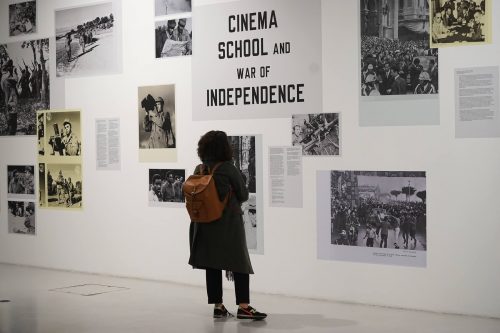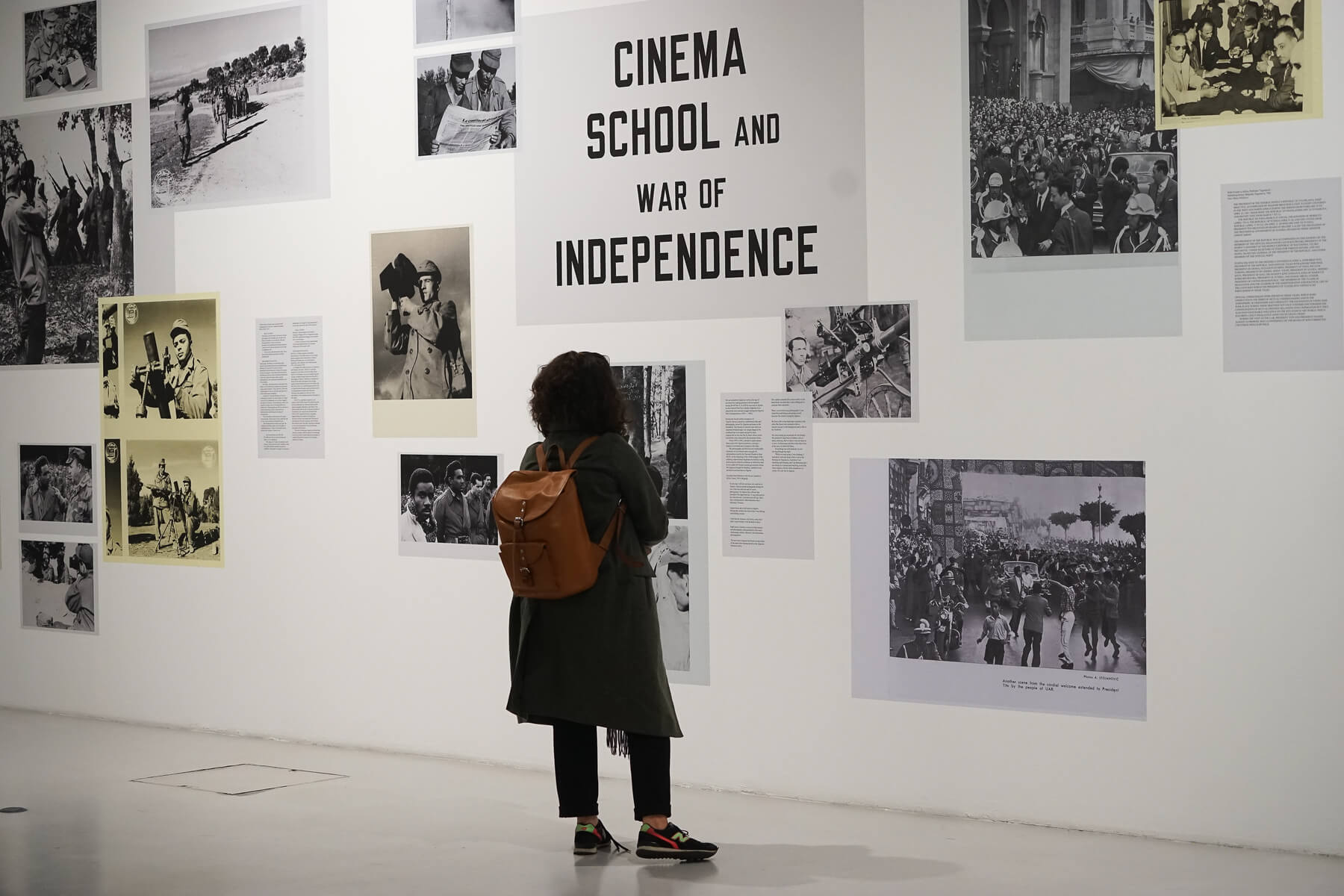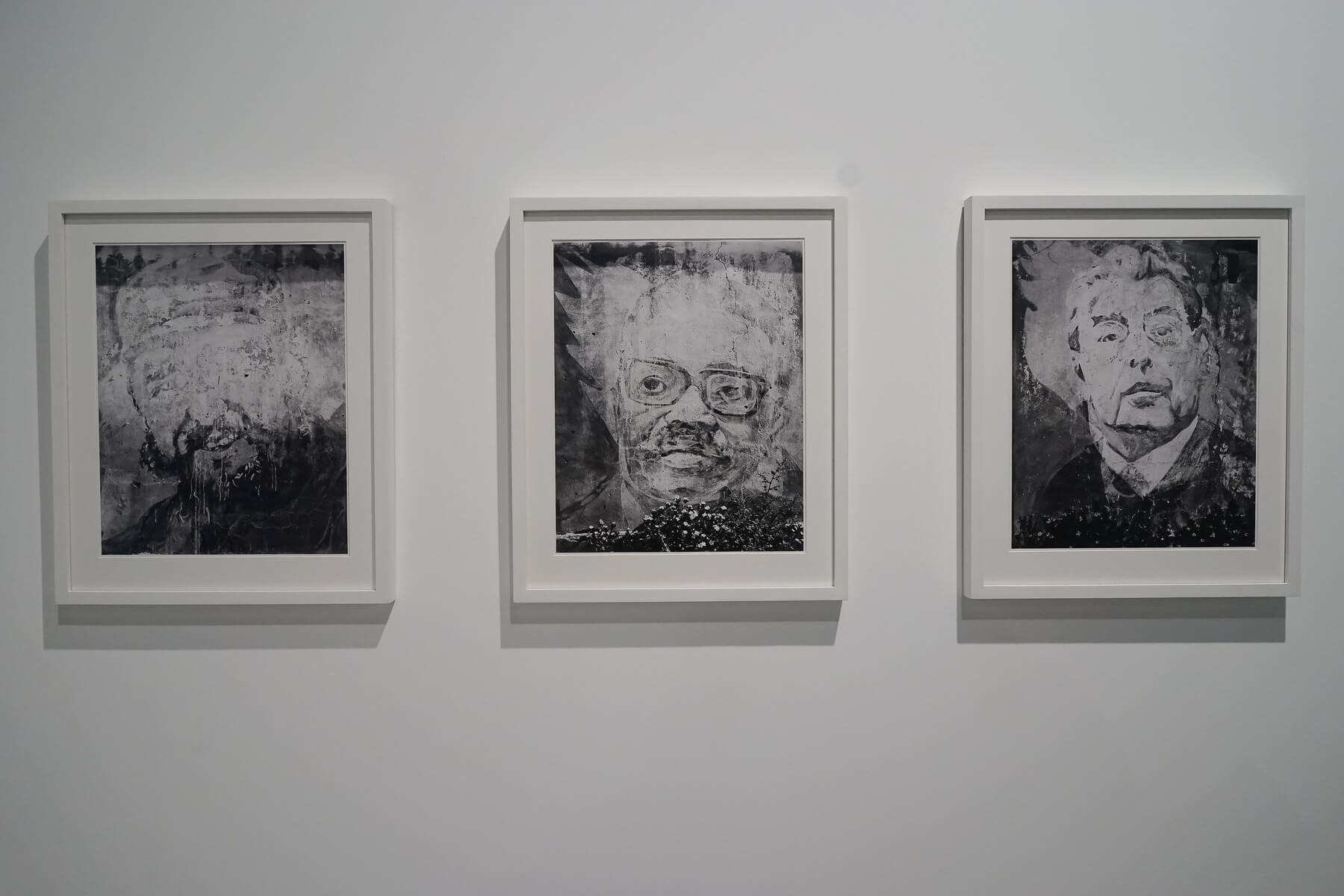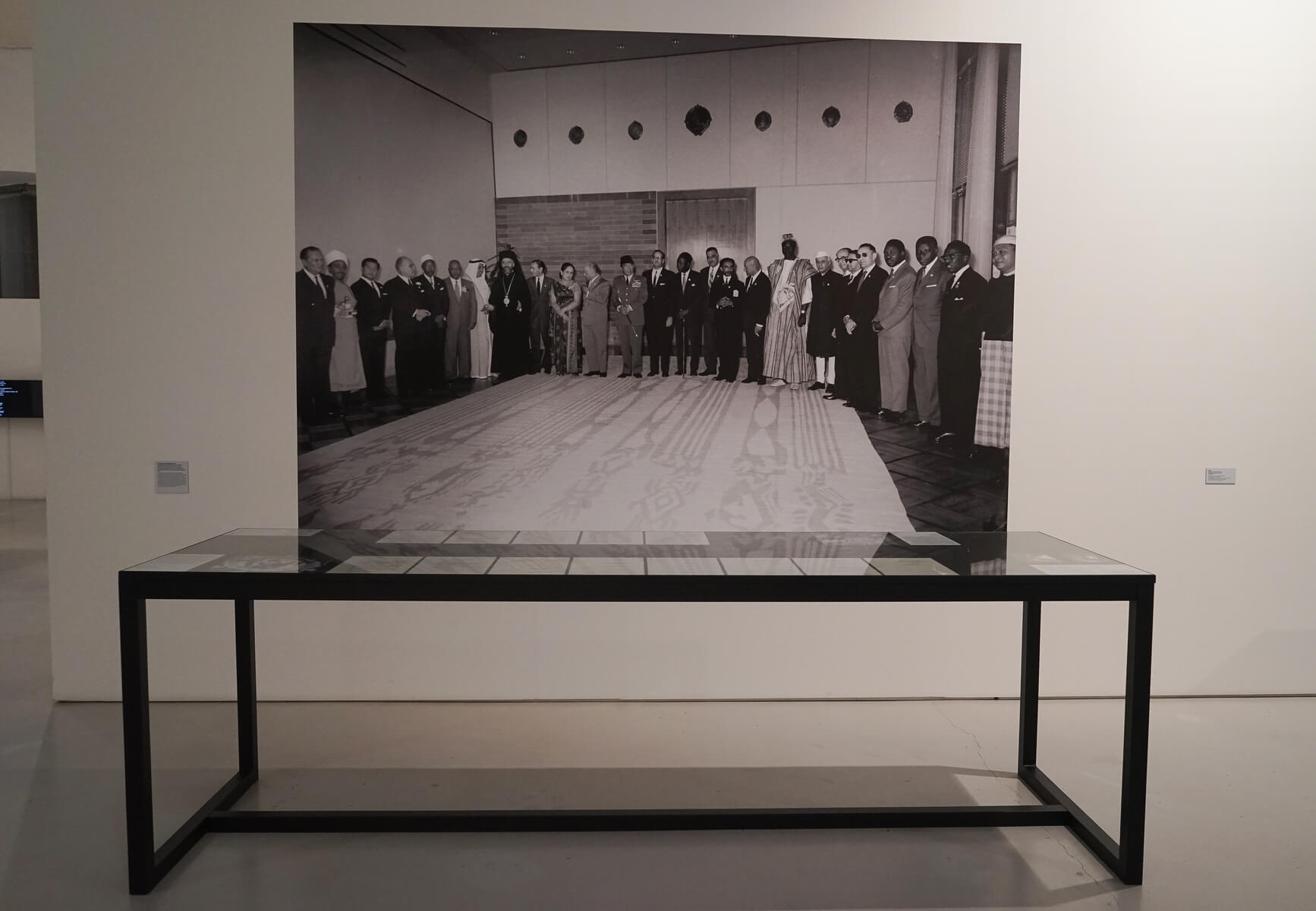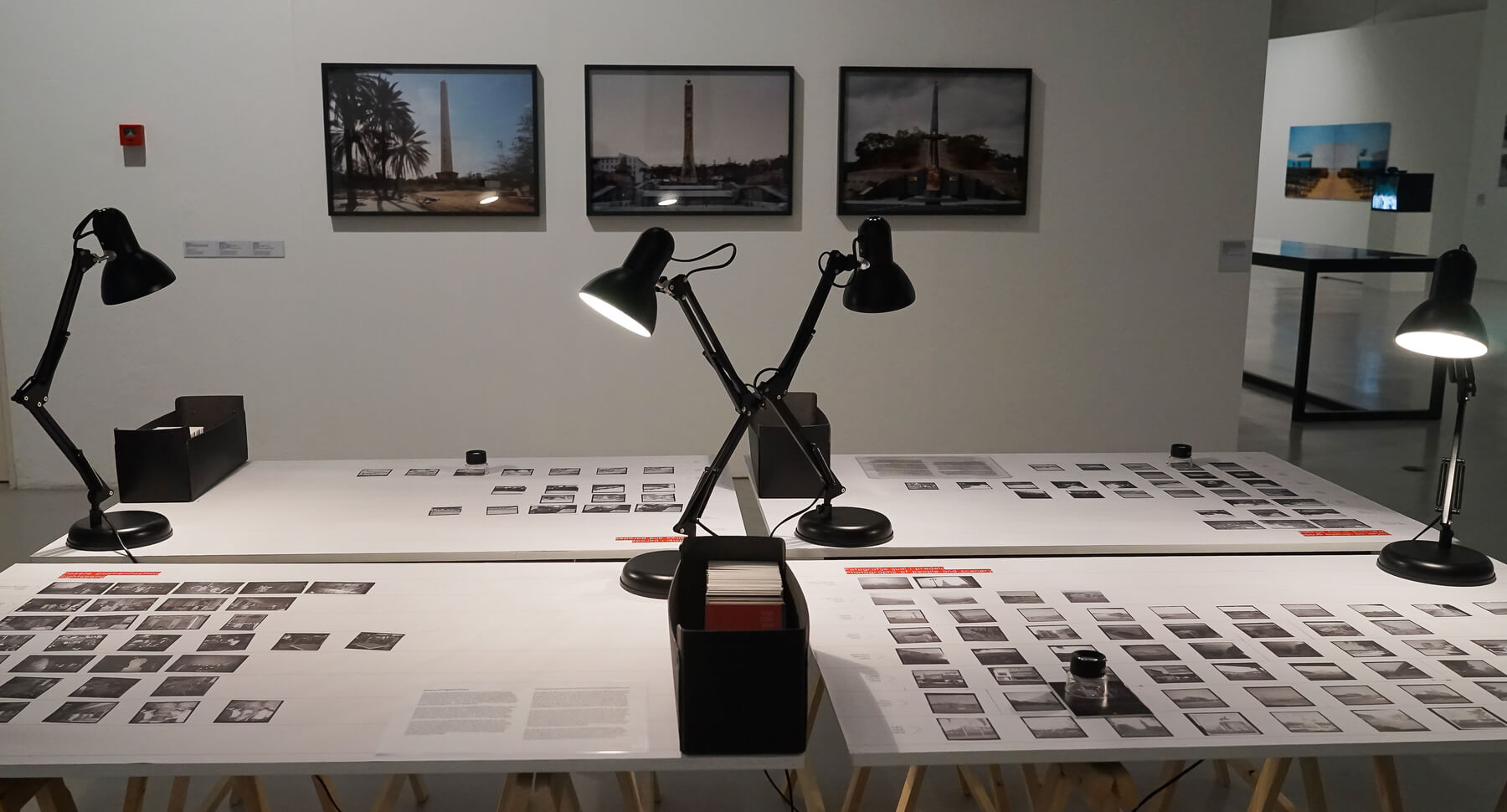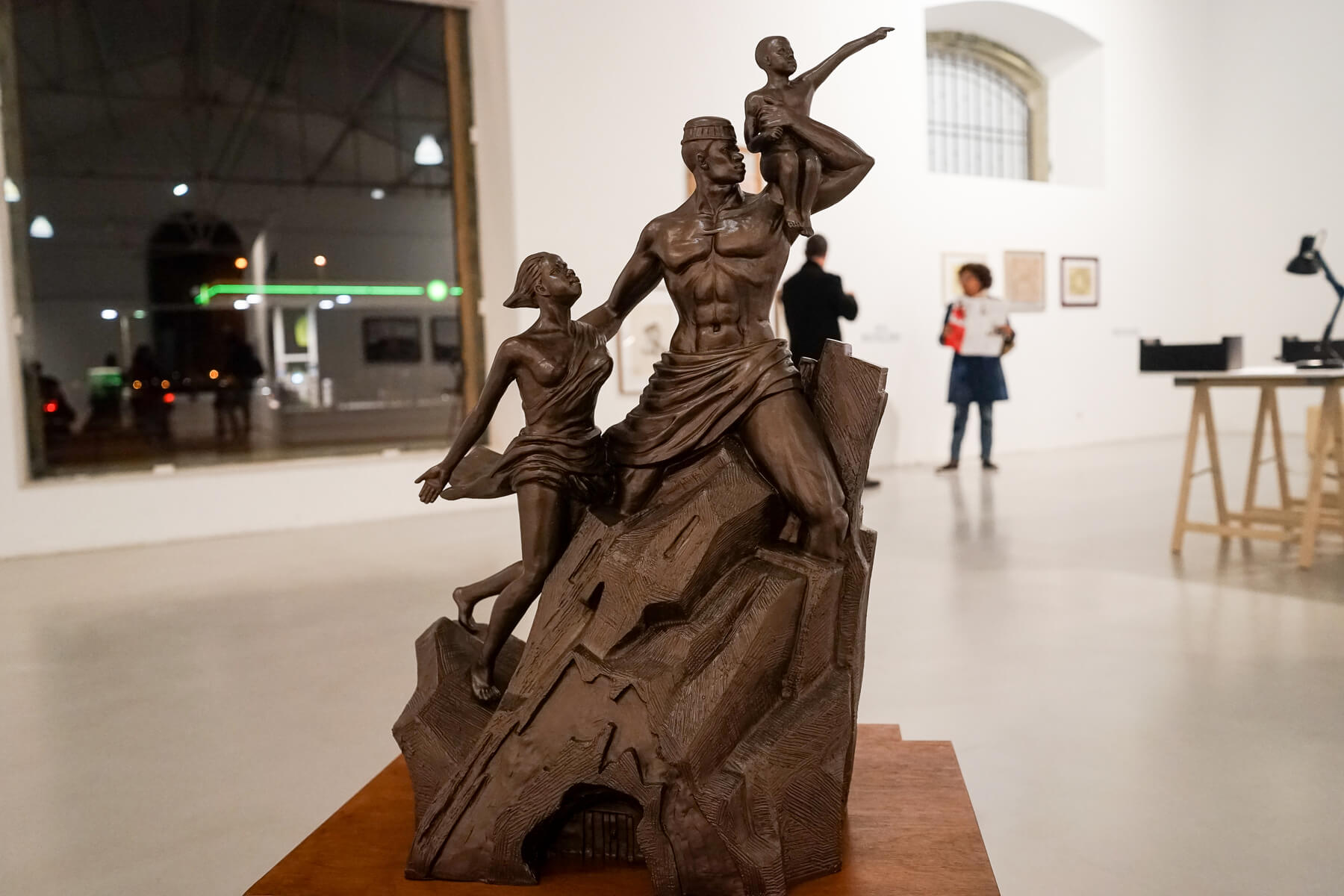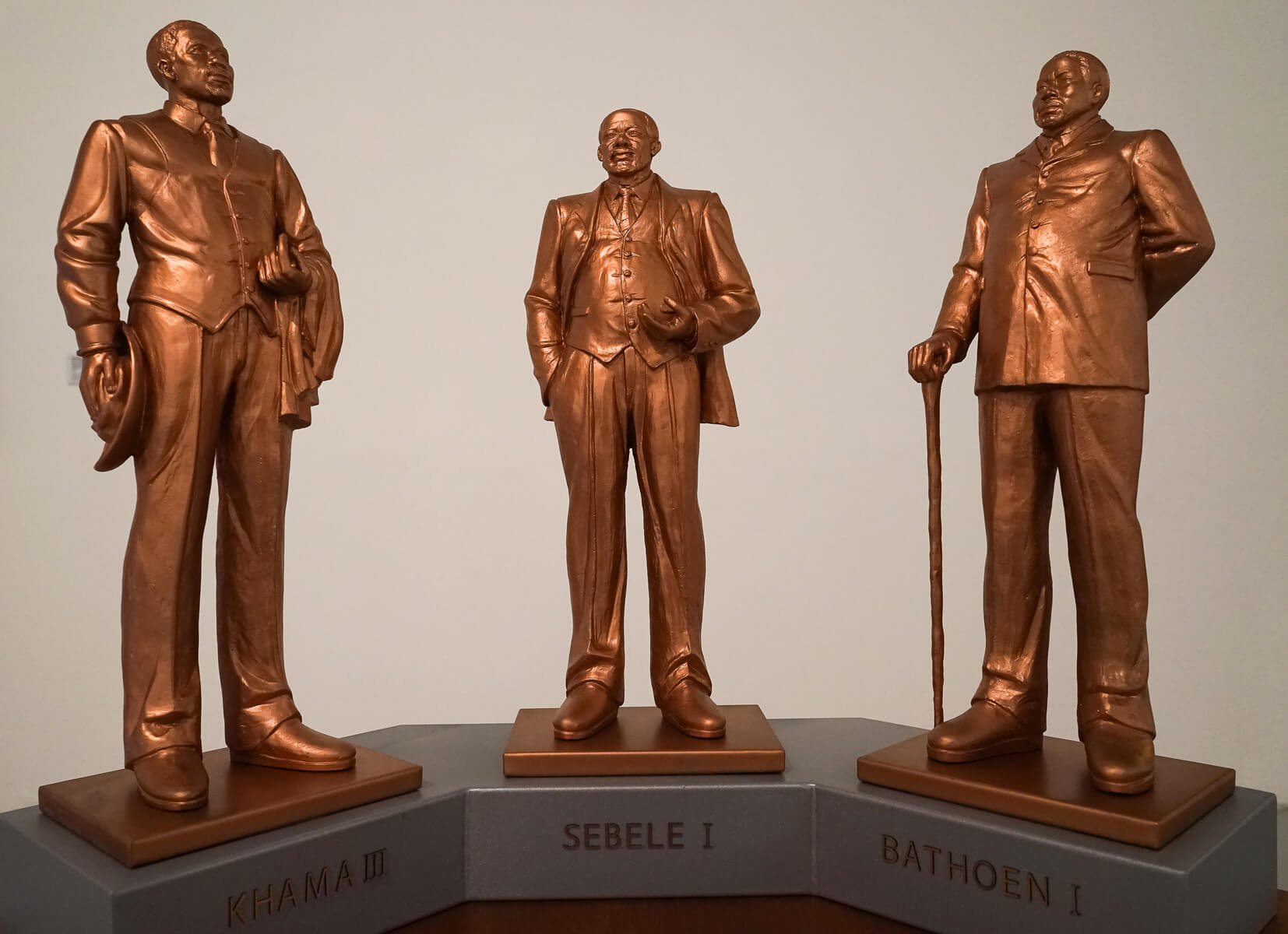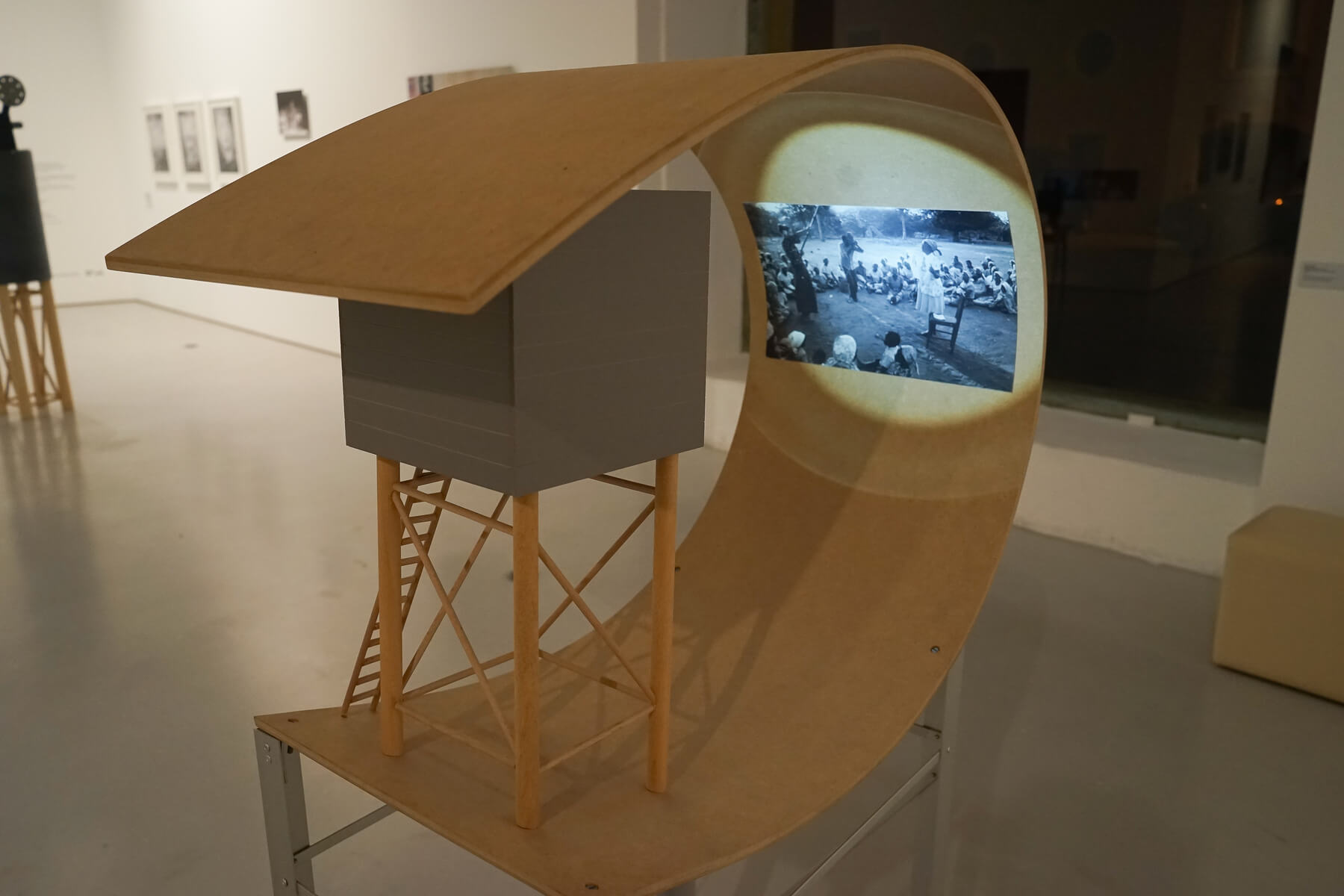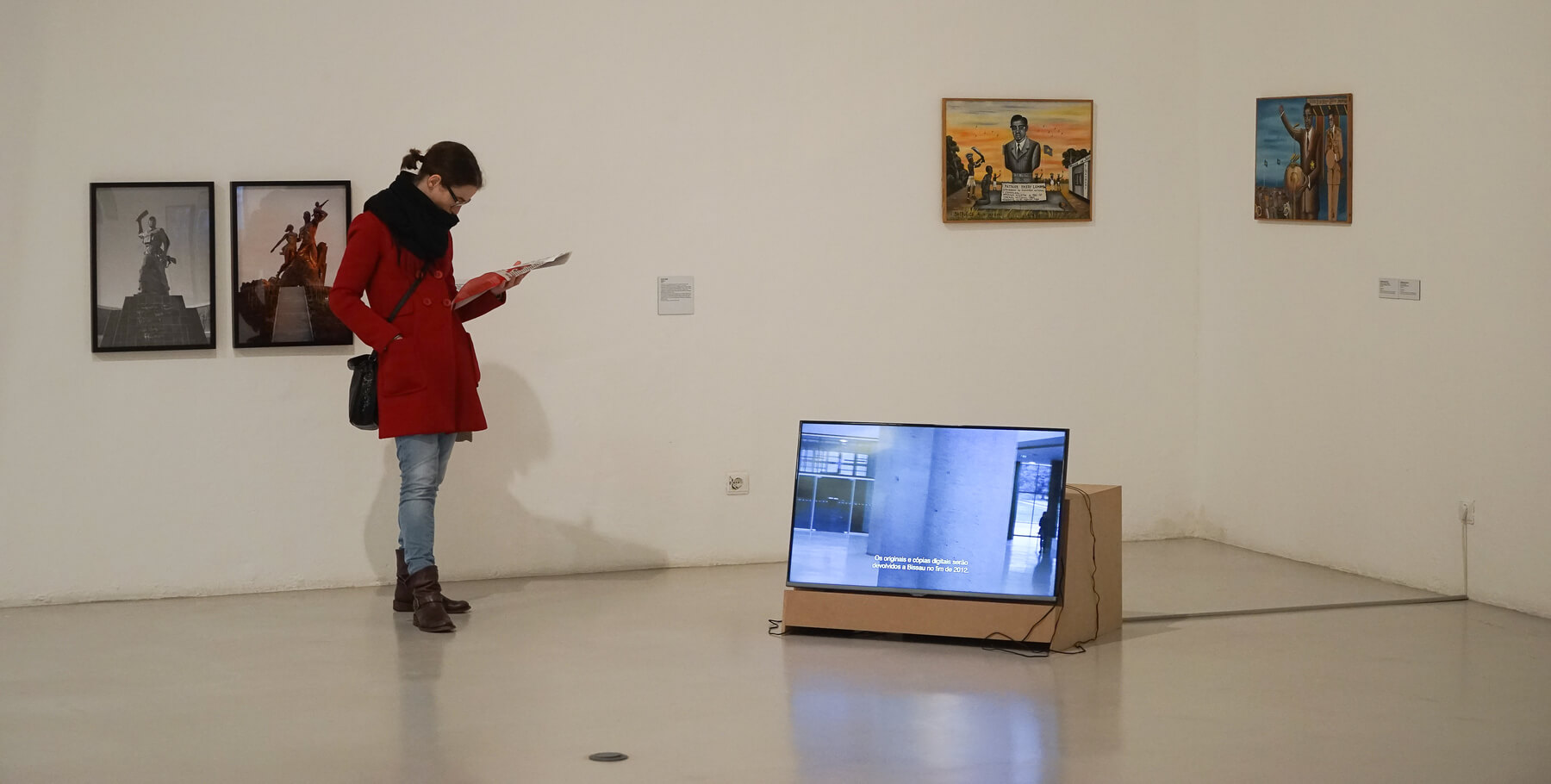– 03.03.2017
EGEAC – Galerias Municipais/AFRICA.CONT presents the programme RED AFRICA and the exhibition Things Fall Apart curated by Mark Nash. The exhibition features artists, film-makers and groups from across Africa, Asia, Europe and North America. Drawing on film, photography, propaganda and public art, the exhibition presents interdisciplinary reflections on African connections to the Soviet Union and related countries.
The exhibition Things Fall Apart takes its title from Chinua Achebe’s 1958 classic of post-colonial fiction, Things Fall Apart. Seen by many as the archetypal modern African novel in English, the book reflects on the devastating impact of colonialism in Africa. The exhibition uses this association to focus on a similar loss of utopian perspective following the end of the Cold War and collapse of the Communist Bloc’s investment in African cultural and political development. Things Fall Apart presents fifteen contemporary artists’ projects linked to this theme in different ways.
The exhibition continues the work of the Socialist Friendship research strand (Calvert 22, 2013-2015) exploring the Soviet educational bursary scheme supporting countries that were conducting anti-colonial liberation struggles and developing Communist cadres within them. Connections were particularly strong with countries such as Mozambique, Ghana, Ethiopia and Angola that were conducting liberation struggles or which, post-independence, were part of the Non-Aligned Movement. The starting point for this research project, a radio programme produced by Burt Caesar for BBC Radio 4 in 2009 called Black Students in Red Russia, is available to listen to in the gallery.
Things Fall Apart has a particular focus on cinema as a means of developing a militant aesthetic, one intended to imagine a future independent of the colonial powers as well as creating international links between African countries and the developing and Communist worlds.
The civil war that began in 1975 following Angola’s independence from Portugal saw the involvement of the Soviet Union, Cuba and the United States, amongst others, who supported rival political factions in an attempt to gain influence over the newly independent country. Two photographic works by Kiluanji Kia Henda, who lives and works in Luanda, Angola and Lisbon, Portugal, record traces of Cuban and Soviet support during the Cold War.
The black and white photographic works of South African photographer Jo Ractliffe also offer a view of contemporary Angola and reflect on its recent history. Ractliffe first travelled to Angola in 2007, five years after the end of the civil war. The four works featured in the exhibition belong to the series Terreno Ocupado (2007-2008) and As Terras do Fim do Mundo (2009-2010), and address contemporary Luanda and the landscapes of conflict (including the ‘Border War’ between Angola and South Africa, 1966-1989). The triptych of murals depicts three key leaders implicated in the Angolan Civil War, the Cuban leader Fidel Castro, the Soviet leader Leonid Brezhnev and Angola’s first president, Agostinho Neto.
Staged at the Haus der Kulturen der Welt, Berlin, Filipa César’s Conakry (2012-2013) is a 16 mm film that revisits a reel from the Guinean archive which documents an exhibition organized by Amílcar Cabral at the ‘Palais du Peuple’ in 1972 in Conakry, reporting on the state of the war against Portuguese rule. César invited the Portuguese writer Grada Kilomba and the American radio activist Diana McCarty to reflect on these images and their history.
The Wayland Rudd Archive, collected by Yevgeniy Fiks (born in Moscow, lives in New York) and displayed here as a projected series of digital images, focuses on the representation of Africans and African-Americans in Soviet visual culture. It is comprised of over 200 Soviet images (paintings, movie stills, posters, graphics, etc.) from the 1920s to the 1980s. Wayland Rudd was an American actor who moved to the Soviet Union in 1932. During Rudd’s twenty-year-long career there, he appeared in numerous films, theatrical performances and plays. Although only a small section of the assembled images in The Wayland Rudd Archive are of Wayland Rudd himself, the project is given his name to commemorate this African American-Soviet actor’s personal story as a case in point of the complex intersection of race and communism in the 20th century American-Soviet narrative.
The Travelling Communiqué project conceived by Armin Linke, Doreen Mende and Milica Tomić explores the idea of political friendship. Its point of entry is the collection of 1,200 photographs taken during the first Conference of the Non-Aligned Movement (NAM), held in Belgrade in 1961. Those who were fighting imperialism and colonialism in Africa, Asia, Europe and Latin America set a collective message from the 25 delegates to the NAM conference to the outside world. At that moment, the NAM could be understood as a third space of emancipation, one that sought to unsettle a bipolar world without the establishment of a third power bloc.
Our Africa (2016) by filmmaker Alexander Markov, based in St Petersburg, uses footage from the Russian State Film and Photo archive to expose the mechanisms behind the creation of Soviet propaganda films that sought to record the expansion of ‘glorious socialism’ across the African continent. This project is part of a feature length documentary by Markov, currently in post-production.
On Labudovic: Cinema, School and War of Independence (2014-2016), a new work by Milica Tomić, based in Belgrade, Serbia, explores a logic of complicity and political trust through the work of photographer and film-maker Stevan Labudović. He began his work at the age of seventeen by making partisan wall newspapers during World War II. In 1959 he was sent to Algeria by Central Film News Studio (Yugoslavia) to support the anti-colonial struggle during the Algerian War of Independence (1954 -1962). Labudović spent almost three years with Algerian partisans, carrying a camera in one hand and a weapon in the other, and established a film and photography school for the partisans on the battlefield.
Both works shown by London-based artist Isaac Julien were produced during his moving image installation Fantôme Afrique (2005), which weaves cinematic and architectural references through urban Ouagadougou, the center for cinema in Africa, and the arid spaces of rural Burkina Faso. In defiance of World Bank prescriptions, under revolutionary leader Thomas Sankara, Burkina Faso developed a creative industries economy focusing on film and television production and continues to host Sub-Saharan Africa’s major biennial film festival. Julien’s Cinema Cinema presents one of the open-air cinemas in Ouagadougou. Place des Cinéastes shows a roundabout in the capital of Burkina Faso, which celebrates the mechanical elements of the camera and projection apparatus.
Shown together for the first time, the three maquettes for sculptures by Lisbon-based artist Ângela Ferreira, who was born in Maputo, Mozambique and grew up in South Africa, pay homage to the film workshops that Jean Rouch, the French filmmaker and ethnographer, established in Mozambique. After the declaration of independence in 1975, Rouch and a team of filmmakers arrived in Maputo in 1976 to run a series of Super 8 workshops at the University Eduardo Mondlane and various rural communities, where Rouch tested his ideas of using Super 8 film as a tool for development. The photographs that form part of Study for Monument to Jean Rouch’s Super 8 film workshops in Mozambique (2011-2012) were made by Françoise Foucault in Mozambique for the purpose of documenting the working process and various filming and screening locations during the Super 8 film workshops.
The installation by Cuban artist Tonel, who lives and works in Vancouver, reflects on the historic relationship between the USSR and Cuba through the lens of the space race, real and imaginary. The objects displayed in the vitrine supposedly belonged to the team of international (Cuban, Soviet, German, American) rocket scientists known as the ‘Heroes of Baikonur’. These objects are accompanied by pages from the artist’s book Dispatches from the War Zone (2009-2014), which has its own soundtrack created in collaboration with Bob Turner, a Vancouver-based musician. The installation also includes three framed drawings.
For the last few years, South Korean artist Onejoon Che has been working on a project related to monuments and architectures in Africa built by North Korea. Mansudae Master Class (2015) continues the artist’s previous explorations of links between military and economic geopolitics and is presented in a feature-length film, photographs and installations. Established in 1959 by the order of Kim Il-sung, Mansudae Art Studio plays a central role in enhancing North Korea’s national image by producing statues and portraits of the Dear Leader. In 1974, it erected the Tiglachin Monument in Ethiopia and subsequently donated public buildings and monuments in a number of African countries including Madagascar, Togo and Guinea. In 2010, Mansudae Overseas Projects received new attention when the African Renaissance monument was unveiled in Dakar, the capital city of Senegal.
Radovan Cukić (Belgrade) and Ivan Manojlović (Belgrade), curators from the Museum of Yugoslav History, Belgrade, present a selection of images from the digitized Presidential Archive of Josip Broz Tito. Set up in 1947, as part of the Press Division of the Cabinet of the Marshal of Yugoslavia (subsequently the Cabinet of the President of the Republic), with the aim of documenting the social and political activity of Tito, it contains over 200,000 negative films of all the important events from 1947 to 1980 that Tito participated in. Selected photos made by Dragutin Grbić, Miloš Rašeta, Aleksandar Stojanović and Mirko Lovrić were developed and handed over to Tito in 708 book-shaped boxes that thus came to be his private i.e., ‘family album’, which was exhibited after his death in his official residence that was subsequently turned into the Museum of Yugoslav History.
Paulo Kapela creates depictions of his inner universe, combining Bantu philosophy, Catholicism, Rastafarianism and socialist iconographies together with a strong sense of a local praise culture. In paintings and collages of various sizes he depicts personalities from the international media. There are works showing Angola’s current president José Eduardo dos Santos next to one of the first presidents, Agostinho Neto. A socialist iconography is clearly visible both in the way he depicts revolutionary figures such as Deolinda Rodrigues or Hoji-ya-Henda, but also by the use of socialist symbols such as the red star or the emblematic icons of the socialist nation like the machete and the hoe.
The Congolese painter Tshibumba Kanda-Matulu depicts important events and personalities in his works. In 1960 Congo (DRC) became independent and Patrice Lumumba – politically directed towards socialism – gave his famous speech, in which he sharply condemned colonial policies. Lumumba’s regime lasted only ten weeks. With Belgian support, General Joseph Mobutu took power and Lumumba was arrested and killed under mysterious circumstances.
-Mark Nash, curator
– 03.03.2017

